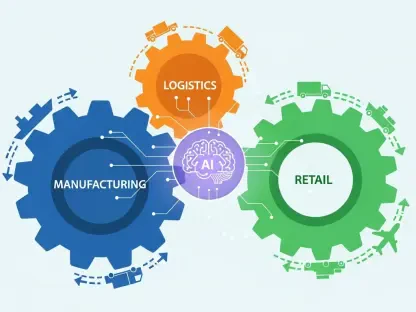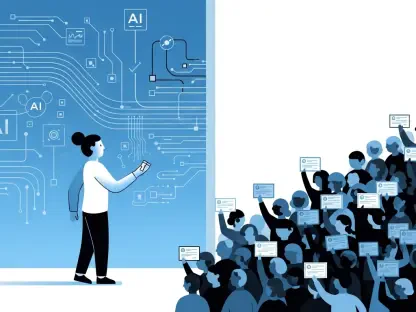Artificial intelligence (AI) is poised to revolutionize the global job market, a reality underscored by recent insights and projections from a United Nations (UN) report. As AI becomes more embedded in industries worldwide, its capacity to impact 40% of jobs highlights significant shifts in employment landscapes. This transformative potential of AI carries both promises of enhanced productivity and concerns over job displacement, presenting a dual narrative of growth and disruption. The article delves into the intricacies of AI’s influence on employment, emphasizing the need for balanced and inclusive approaches to maximize benefits while mitigating inherent risks.
The AI Market Surge
Unprecedented Growth Projections
The UN Conference on Trade and Development (UNCTAD) projects a dramatic rise in the global AI market, estimating its value to reach an astonishing $4.8 trillion by 2033, a figure equivalent to Germany’s current economic size. This projection positions AI as a leading frontier technology, reflecting its vast potential and transformative impact across various sectors. As AI continues to evolve, its integration into industries promises unprecedented advancements, enhancing capabilities from automation to data analysis. The projected growth not only underscores AI’s role as a technological frontrunner but also its influence in shaping the future economy.
However, amid these promising prospects, there are underlying concerns that AI’s rapid market expansion might not benefit all regions equally. Advanced economies with robust technology infrastructures and investments are likely to capitalize more effectively on AI developments, whereas developing nations might lag due to limited resources and expertise. The disparity in AI adoption rates could exacerbate existing global inequalities, necessitating focused efforts to ensure equitable benefits. Without strategic interventions, the potential for AI to widen the economic gap remains a significant challenge.
Economic Impact and Disparities
While AI’s growth projections are impressive, the UN warns of potential risks that this technology might deepen existing economic inequalities. A key concern is AI’s tendency to favor capital over labor, which could skew benefits toward those who already possess significant resources. Such dynamics may exacerbate disparities between developed and developing nations, which often have contrasting levels of technological advancement and investment capabilities. The economic impact of AI thus becomes a complex narrative, balancing between growth opportunities and potential risks of exacerbated inequalities.
In developed nations where capital is more readily available, firms can more effectively invest in AI infrastructure, reaping substantial returns. On the other hand, developing countries might struggle to harness AI’s full potential due to resource constraints. This uneven distribution underscores the need for policies that bridge the gap and promote inclusive growth. Ensuring that AI benefits are distributed fairly requires concerted global efforts, including strategic investments in digital infrastructure, education, and workforce development to empower all regions to leverage AI’s transformative power.
Employment Sector Transformation
Knowledge-Intensive Sector Disruption
As AI progresses, its impact extends beyond traditional blue-collar jobs, significantly influencing knowledge-intensive sectors. This marks a shift from earlier technological advancements that primarily affected manufacturing and manual labor. Advanced economies, characterized by knowledge-intensive industries such as finance, healthcare, and education, may experience profound disruptions. AI’s capabilities in automating complex tasks and enhancing analytical processes challenge the status quo, prompting a reevaluation of job roles and industry practices.
The transformative effect on these sectors brings both opportunities and challenges. On one hand, AI can streamline operations, improve efficiency, and drive innovation, potentially creating new job roles that leverage AI skills. Conversely, the automation of certain tasks might displace workers who lack the necessary AI expertise. This dual impact necessitates a strategic approach to workforce adaptation, including reskilling and upskilling initiatives that equip employees with relevant AI competencies. Preparing the workforce for AI-induced changes is crucial for minimizing job displacement risks and fostering a resilient employment sector.
Advantages for Developed Economies
Despite the potential disruptions AI may bring, advanced economies are better equipped to harness its benefits due to their stronger resources and infrastructure. These nations can effectively invest in AI-powered innovations, driving productivity and growth. Their established technological ecosystems provide a fertile ground for AI integration, allowing businesses and institutions to capitalize on its advantages. The ability to strategically implement AI and adapt workforce practices positions developed economies at the forefront of this technological revolution.
Moreover, developed economies have the capability to fund educational initiatives aimed at workforce reskilling, ensuring employees are not left behind by AI advancements. By fostering an environment conducive to continuous learning and adaptation, these nations can transform potential AI-induced challenges into growth opportunities. The proactive investment in AI infrastructure and workforce development further solidifies their global competitive edge, enabling them to navigate the complexities of AI’s impact on employment with greater resilience and foresight.
Equity in AI Development
Concentration of AI Expertise
One of the UN report’s significant findings is the concentration of AI research and development among a limited number of firms, predominantly based in the US and China. This concentration poses challenges for global equity in AI advancements and applications, as it restricts access to cutting-edge technologies and expertise to a few dominant players. The imbalance in AI infrastructure and knowledge raises concerns about the equitable distribution of AI benefits, emphasizing the need to address these disparities and promote inclusivity in AI progress.
The concentration of AI expertise in a handful of economies can create barriers for other nations striving to develop their AI capabilities. This global imbalance necessitates policies and collaborative efforts to democratize AI knowledge and resources. By fostering international partnerships and open-source initiatives, countries can bridge the gap and ensure more inclusive access to AI advancements. Equitable AI development hinges on a collective commitment to share benefits and knowledge, fostering global cooperation that transcends technological boundaries.
Global Cooperation and Inclusion
A pivotal aspect of the UN report is the call for including developing nations in discussions related to AI governance. Ensuring that these countries have a voice in shaping AI policies and frameworks is crucial to prevent the confinement of AI benefits to advanced economies alone. Strengthening international cooperation is imperative for fostering inclusive growth, enabling developing nations to fully participate in and benefit from the AI revolution.
Global collaboration can take various forms—increased technology transfer, joint research initiatives, and investments in digital infrastructure. By integrating diverse perspectives into AI governance, policies can be tailored to address the unique challenges faced by different regions. Developing nations stand to gain significantly from such inclusive approaches, as they can leverage AI for economic growth and development. Inclusive AI policies promote a sustainable future where technological advancements benefit a broader spectrum of the global population.
Measures to Mitigate Risks
Investing in Infrastructure and Reskilling
To mitigate the potential risks associated with job displacement, the UNCTAD report advocates for proactive measures in digital infrastructure investment and workforce reskilling and upskilling. Ensuring that employees are equipped with the necessary skills to adapt to emerging AI-induced roles is paramount. Strategic investment in education and training programs can prepare the workforce for future challenges, minimizing the adverse effects of automation and enhancing employability.
Countries must prioritize building robust digital infrastructures that support AI development and integration across various sectors. Such initiatives not only promote technological advancements but also create avenues for job creation and economic growth. By fostering a skilled and adaptable workforce, nations can navigate AI’s impact on employment with greater resilience, transforming potential risks into opportunities for innovation and productivity.
Creating Equitable AI Governance
Artificial intelligence (AI) is set to transform the global job market, as highlighted by a recent United Nations (UN) report. The growing integration of AI across various industries worldwide suggests it could impact up to 40% of jobs, signaling major changes in employment patterns. This transformative capability of AI brings both prospects of heightened efficiency and productivity and fears of significant job loss, creating a narrative that balances growth with disruption. As industries adopt AI technologies, the article stresses the importance of fostering balanced and inclusive strategies to fully harness the potential benefits while addressing and mitigating the inherent risks. The need for targeted training programs and ongoing education becomes crucial in preparing the workforce to adapt to these changes. By developing policies that support workers and encourage innovation, societies can better navigate the complexities of AI-induced shifts in the job market, ensuring a future where technology enhances rather than displaces human work.









